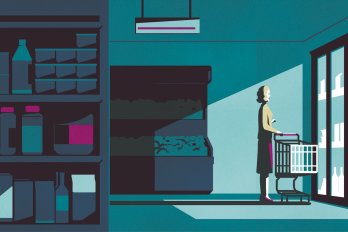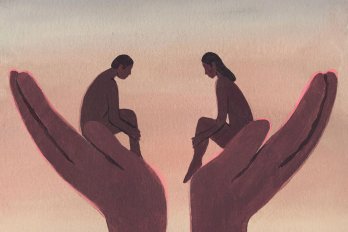I
I’d read the airline regulations and had the fish in his bowl in a sealed plastic bag with a small amount of water. I had, in my luggage, several vials of water to pour on him once we’d gone through the X-ray. I told people behind me in the queue they might be better off in another line. Security took one look at the goldfish bowl on the conveyor belt and said, “No, no, you can’t bring a fish on board.” I said there was nothing in the regulations about a live fish. The line was halted and a manager fetched, who sized up the situation and also said no. We continued up the chain in this way until the person who, I think, built the airport security system came and agreed with me that, technically, I was allowed to bring the goldfish on board.
For the plane, I had a book about, among other things, German submarines. I had the fish on the floor between my feet, and a combination of the stress of departures and the subject of the book put me fast asleep. When I woke up, the fishbowl was gone. A flight attendant quickly came and whispered that the man in front of me was experiencing breathing problems and they’d had to put a canister of oxygen beneath the seat, and they had discovered my goldfish. “Don’t worry,” she said. “Your fish is in the cockpit.”
“Are you saying,” I asked, “that my goldfish is pretty much copiloting this flight?”
For various complicated reasons, I had a baby and lived in a small apartment in Toronto. The place was so small that, at Christmas, we’d get a live potted tree to decorate and put presents under. In January, I couldn’t throw out the tree. It felt cruel. So I stored it on the back porch and fed and watered it once a month. I didn’t know what to do with it. In the spring, I was going to Newfoundland and I thought, “I’ll bring the tree.”
It fit in my carry-on. And I flew there, drove the tree out to the house, dug a hole, and planted it. Now, after ten years, there’s a grove of my son’s Toronto Christmases in front of the Newfoundland house.
In the spring, in Newfoundland, I saw an iceberg and, of course, thought: bring it to Toronto.
The iceberg was melting and a small chunk, a “growler,” floated in to shore. I climbed down a rock face and chopped some off with an axe. A few days later, I was at the Griffin Poetry Prize, in Toronto, with a slab of that iceberg in a cooler. Seamus Heaney was at the bar, and I asked if he wanted any ice in his drink. He put a whole lump in his whisky.
A year later, he was dead.
It gets worse, these things I’ve brought aboard airplanes.
There was an apple tree nestled in the Newfoundland woods. Some fisherman a hundred years ago had tossed an apple out while farming, I supposed.
It took me all summer to figure it out.
In the fall, just before my return to Toronto, I went back to visit the tree and picked the apples. I brought the apples on board a flight and ate them with my son in Toronto. My mother explained “stratification”: you put seeds in damp paper in a bag in the fridge for a few months. This helps them germinate.
Now I have that Newfoundland apple tree growing in our Toronto backyard.
What else? I travelled to Egypt and a friend asked me to bring a piece of labradorite to throw into a Giza pyramid. Why? “To confuse the archaeologists,” he said.
Check.
The one thing I could not take aboard a plane was a pocket knife.
I had forgotten I had it on me—I was on my way to departures in St. John’s. I really liked the knife and I was sad to think of losing it. I realized, of course, what I was doing: I was living the life of a shepherd migrating his flock up and down the valley and mountain with the change of seasons. It’s called transhumance, this activity, and the airplane was my modern method of movement.
There was a large potted plant beside the escalator. I took the knife out and stuck it in a grocery bag. I dug a hole beside the plant and buried it.
Eight months went by.
When I returned, I found the plant by the escalator. And I dug up my knife.





